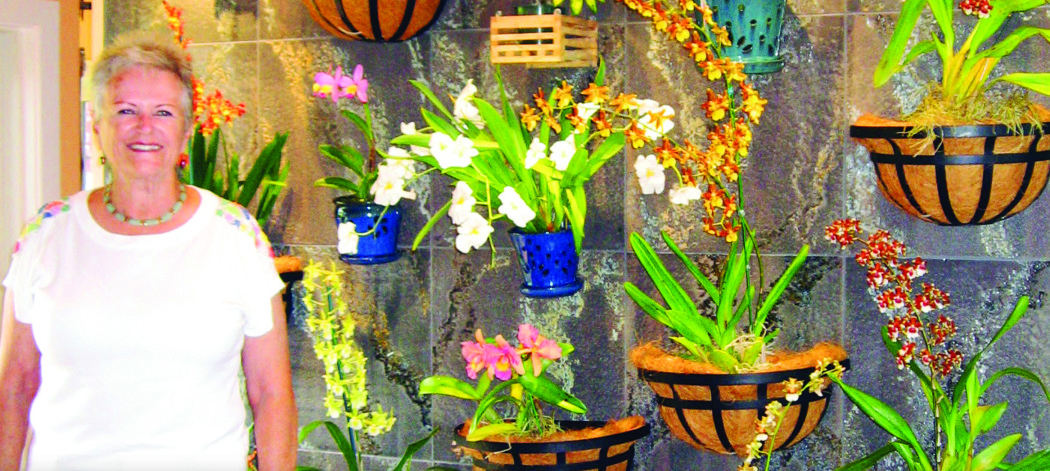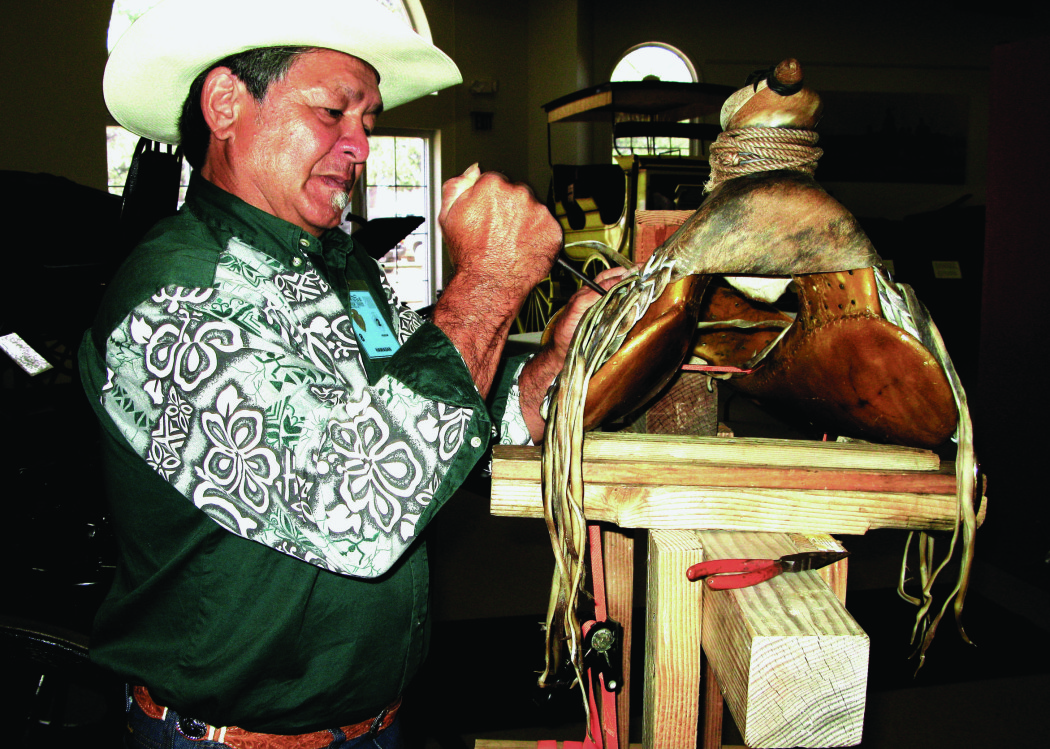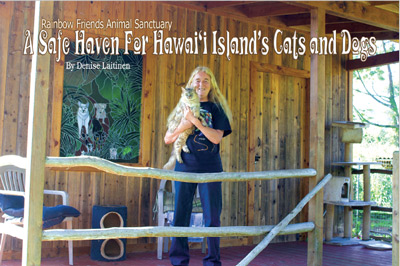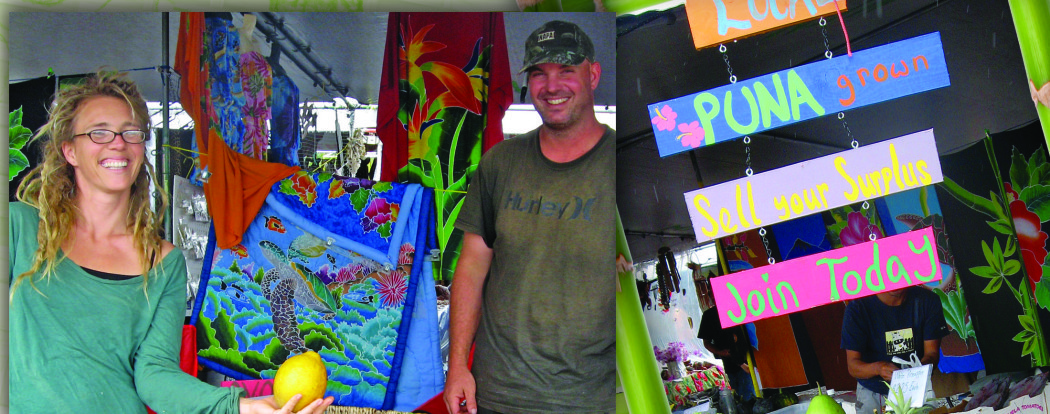
A Home Built Around Orchids: Love of a Flower Inspired a House Project
 By Denise Laitinen
By Denise Laitinen
When Julie Goettsch saw the orchid wall at the Kahala Resort on O‘ahu back in 1969 she vowed to herself that someday she would have a similar wall in her home. It took 40 years and a few detours, but Julie’s dream of an orchid wall finally came true in 2010 when her house in Hakalau was built entirely around orchids.
“The Kahala Resort—at that time, the Kahala Hilton—had an incredible orchid wall made out of lava rock, and I was just so taken with them,” she says. Goettsch first moved to Hawai‘i to work as a schoolteacher. “I just totally fell in love with orchids at the time,” she said.
Then she wound up moving to Colorado, where she worked as an educator and then as a project executive for IBM. “I took a little detour for 33 years,” she said with a chuckle. But her love of orchids and Hawai‘i remained. “In Colorado I tried to grow orchids. I grew them on a stepladder in my living room. There was snow up to the windowsills and it would be seven degrees outside, but they were blooming away.
“I knew that when I retired I wanted to come back to Hawai‘i. I chose Hilo and this area [Hakalau] because of the ease of growing orchids,” explained Goettsch. “When I built my house, I purposely designed the foyer to have an orchid wall like what I’d seen at the Kahala Resort. I built the orchid wall so that it’s the first thing people see when they come in.”
She didn’t stop there. Another “must-have” for Goettsch’s dream orchid house was to have a center courtyard for growing orchids. “I built the center garden so I that I could see orchids growing on the ferns from any room in the house,” she added. “The orchid wall and center courtyard were my two ‘gotta-haves’ when I was dreaming of this house.”
How does one go about building a house around a plant species?
“I had a couple of false starts finding builders,” said Goettsch. Then a friend recommended Cheryl Green, owner of Hamakua Drafting, LLC and Green Construction, based in Honoka‘a. Green is one of the few female building contractors on island, and she specializes in building environmentally friendly homes. Green was one of the first contractors on the island to be LEED certified (the Leadership in Energy and Environmental Design is a national certification of the U.S. Green Building Council).
“I always love to support women in business any way I can,” Goettsch elaborated. “We sat down and talked about my ideas. She impressed me right at the beginning by the quality of questions she was asking. Cheryl was able to take my ideas and translate them into how she would actually do it.”
A third-generation contractor, Green grew up in Connecticut and moved to northern California while in her early 20s. She joined the San Francisco carpenters union and rose through the ranks to become a foreman on two major, high-rise projects. After a decade in the union, she got her contractor’s license in 1989 and started doing restoration of Victorian homes.
Growing weary of city living, Green fell in love with the Big Island on her first visit to Hawai‘i. She bought a piece of property during that trip, and before she moved here in 1994, she received her Hawai‘i contractors license.
Green, who is a draftsperson in addition to a carpenter and contractor, designed Goettsch’s house. “What makes [Julie’s] house “green” is the way it was designed—the air-flow and the lighting,” explained the builder. She added that she gave careful thought to the positioning of the house. “I took into consideration the wind, the way the sun rises and sets, and the way it [the sun] comes through the windows.”
“The house breathes,” said Green. “We don’t need air conditioning because of the positioning of the house and the windows. It’s about bringing the outdoors inside in a comfortable way” she added.
Because Goettsch had been thinking about her dream house for four decades, the design phase of the house was pretty easy. “Julie’s plans were preliminary at the time,” explained Green. “We basically took the dream that she had on paper and came up with plans designed specifically for the house site,” she said.
“We didn’t have very many problems because it was so well thought out ahead of time,” she commented. “We were able to turn her plans out in three weeks. At that time the planning department was only taking one month to approve plans, so basically it was three months from introduction to permit.”
In addition to building the house around orchids, Goettsch had a few other ideas she wanted incorporated into the house. “I knew at the time that I wanted to use all solar,” explained Goettsch. “I also wanted the house to look like a representation of the plantation community where I live.”
It was also important to both the homeowner and the builder to use recycled materials as much as possible. “Hardie plank siding used on the exterior of the house contains recycled cellulose,” said Green.
“The floorboards of the sunroom are made from Trex decking made of recycled plastic,” added Goettsch.
The silestone material for the kitchen counters was selected based on the eco-friendly practices used to mine the material. “Silestone is one of the most environmentally friendly countertops available,” explains Green. She said she even used recycled wood from a previous project to make the bathroom vanities.
“We also tried to use local products wherever we could, in addition to recycled products,” explained Goettsch. “For instance all the flooring in the house is made out of ‘ōhi‘a wood, which was grown and milled on island.” Green noted that the ‘ōhi‘a trees were from cleared lots in lower Puna and the wood was milled in Kea‘au. “People didn’t want the wood—it would have gone to waste if we hadn’t bought it.”
Green also pointed out that they used all local labor on the house-building project. “That’s a really important thing, supplying our community with jobs,” says Green. “It’s important to utilize people that live and work here.”
Green said that, while the planning stage went pretty smoothly, there were some issues in the construction phase of the house. Green designed the house for Goettsch’s particular piece of property, which happens to have a steep slope.
“Well, the challenges were the slope of the land,” said Green. “We didn’t want to disturb the slope of the land, so we had to figure out how we could get the height that she has at the front of the house and still fall within the CC&Rs of the community.”
Green met with members of the local homeowner’s association and showed them in great detail that the slope of Goettsch’s roof was indeed no higher than that of her neighbor’s house. But, because they didn’t disturb the land, Goettsch’s house actually looks much higher.
The center orchid courtyard was the first part of the house that was built. Before any framing took place, work crews constructed a 10-foot high concrete box filled with cinder. With the slope of the land, the top of the concrete box, which extends three feet into the ground for stability, is actually ground level when you walk into the back of the house.
The courtyard garden was designed to have two large rocks in it, and the rocks were placed on the top of the concrete box before the house was built. Goettsch laughs as she recalls how she asked the excavator to find two pretty rocks for the courtyard. “He was this old, crusty guy. He said ‘what’s a pretty rock?’ We set those rocks in there before anything else was there.”
As if building a house around orchids weren’t enough of a challenge, Goettsch also wanted her home to reflect her love of Asian antiques. Green incorporated specific antiques into the design of the house while other pieces were built directly into the walls. For instance, the back wall of the foyer rises in a triangular shape to accommodate a 250-year-old triangular-shaped artifact made of mica and teak that originally came from a temple in Thailand.
“Cheryl designed the foyer around the orchid wall, the temple piece, and inset niches for my artifacts from the South Pacific,” added Goettsch.
The house took about 14 months to build and was completed in August 2010. Goettsch, who currently serves as president of the Hilo Orchid Society, quickly set about decorating the house with even more orchids. “I always have orchids on display all over the house,” she said.
“The thing I like about orchids is that it’s kind of symbolic of life in a way.” Pointing out that orchids live in 11 of the 13 climate zones in the world, Goettsch says of the delicate plants, “they adapt themselves to wherever they find themselves. It’s kind of like that with people.
“We have to find the best environment for us to grow and thrive. We’ve all been in situations where we weren’t thriving, and we have to take ourselves and transplant ourselves to a better environment where we can thrive. That’s why orchids are so amazing to me.”
It’s clear both Goettsch and her orchid house have adapted well to their environment. ❖
Contact writer Denise Laitinen


